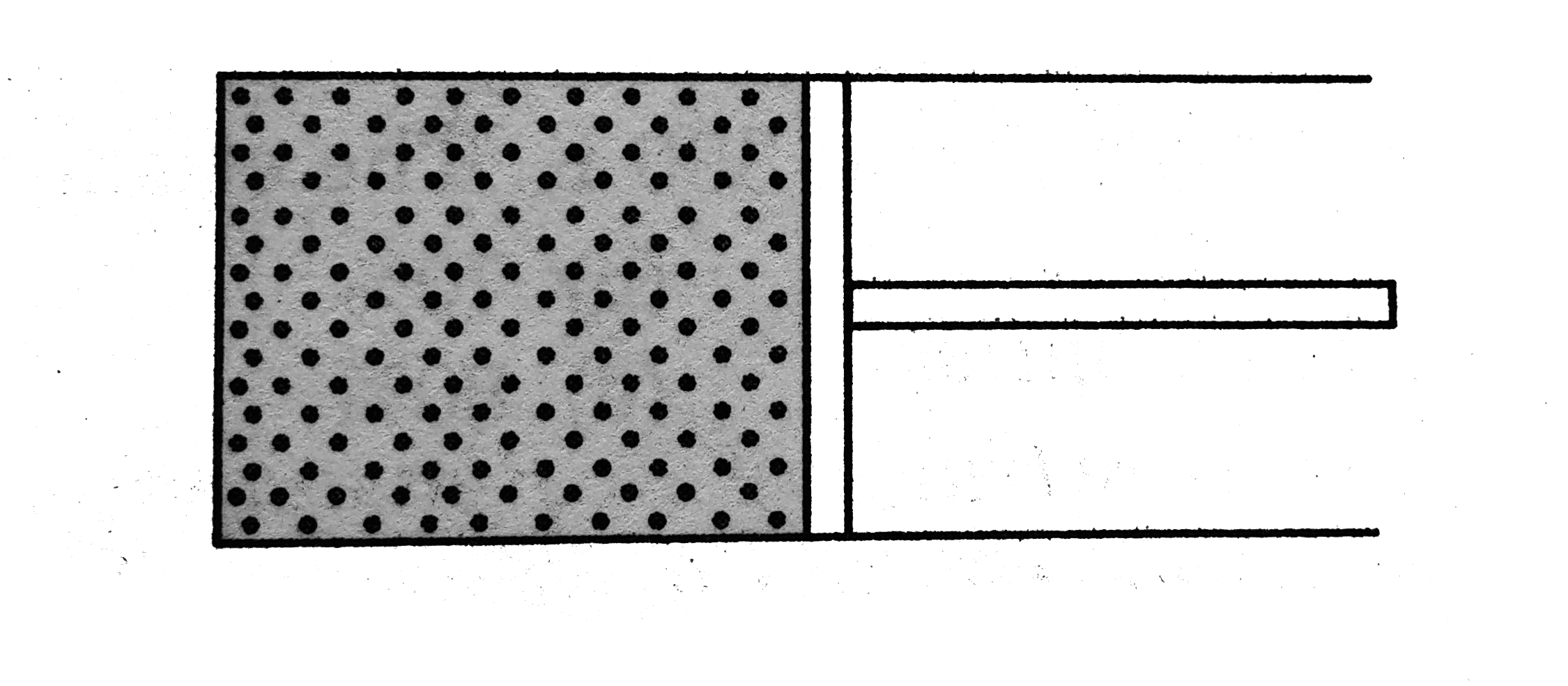In a flexible balloon 2, moles of SO2 having an initial volume of 1 kL at a temperature of 27.∘C is filled . The gas is first expanded to thrice its initial volume isobarically and then further expanded adiabatically so as to attain its initial temperature . Assuming the gas to be ideal , the work done by the gas in the whole process is [γSO2=43,R=253Jmol−1K−1]
10kJ
35kJ
45kJ
15kJ
The correct Answer is:C
To solve the problem step by step, we need to calculate the work done by the gas during two processes: isobaric expansion and adiabatic expansion.
Step 1: Initial Conditions
- Given:
- Number of moles (n) = 2 moles
- Initial Volume (V1) = 1 kL = 1000 L
- Final Volume after isobaric expansion (V2) = 3 * V1 = 3 kL = 3000 L
- Initial Temperature (T1) = 27°C = 300 K (after conversion)
- R=253J/mol⋅K
- γ=43
Step 2: Work Done in Isobaric Process
In an isobaric process, the work done (W) can be calculated using the formula:
W=PΔV
Where ΔV=V2−V1.
To find the pressure (P), we can use the ideal gas law:
PV=nRT
From this, we can express pressure as:
P=nRTV1
Substituting the values:
P=2⋅253⋅3001000
P=2⋅253⋅3001000=2⋅25⋅3003⋅1000=150003000=5J/L
Now, we can calculate the work done:
ΔV=V2−V1=3000L−1000L=2000L
W=PΔV=5⋅2000=10000J
Step 3: Work Done in Adiabatic Process
For the adiabatic process, we can use the formula for work done:
W=nRγ−1(T1−T2)
We need to find T2 after the adiabatic expansion. Using the relation for adiabatic processes:
T1T2=(V2V1)γ−1
Substituting the values:
T1T2=(31)43−1=313
Thus,
T2=T1313=300313
Calculating 313 (approximately 1.442):
T2≈3001.442≈207.3K
Now substituting into the work done formula:
W=2⋅25343−1(300−207.3)
W=2⋅25313(92.7)
W=2⋅25⋅92.7=4650J
Step 4: Total Work Done
Now we can find the total work done in both processes:
Wtotal=Wisobaric+Wadiabatic
Wtotal=10000J+4650J=14650J
Final Answer
The total work done by the gas in the whole process is approximately:
Wtotal≈14650J
- Given:
- Number of moles (n) = 2 moles
- Initial Volume (V1) = 1 kL = 1000 L
- Final Volume after isobaric expansion (V2) = 3 * V1 = 3 kL = 3000 L
- Initial Temperature (T1) = 27°C = 300 K (after conversion)
- R=253J/mol⋅K
- γ=43
In an isobaric process, the work done (W) can be calculated using the formula:
W=PΔV
Where ΔV=V2−V1.
PV=nRT
From this, we can express pressure as:
P=nRTV1
P=2⋅253⋅3001000
P=2⋅253⋅3001000=2⋅25⋅3003⋅1000=150003000=5J/L
ΔV=V2−V1=3000L−1000L=2000L
W=PΔV=5⋅2000=10000J
For the adiabatic process, we can use the formula for work done:
W=nRγ−1(T1−T2)
T1T2=(V2V1)γ−1
Substituting the values:
T1T2=(31)43−1=313
Thus,
T2=T1313=300313
T2≈3001.442≈207.3K
W=2⋅25343−1(300−207.3)
W=2⋅25313(92.7)
W=2⋅25⋅92.7=4650J
Now we can find the total work done in both processes:
Wtotal=Wisobaric+Wadiabatic
Wtotal=10000J+4650J=14650J
The total work done by the gas in the whole process is approximately:
Wtotal≈14650J
Topper's Solved these Questions
Similar Questions
At 27∘C two moles of an ideal monoatomic gas occupy a volume V. The gas expands adiabatically to a volume 2V. Calculate (i) the final temperature of the gas, (ii) change in its internal enegy, and (iii) the work done by the gas during this process.
View SolutionAt 27∘C two moles of an ideal monatomic gas occupy a volume V. The gas expands adiabatically to a volume 2V. Calculate
(a) final temperature of the gas
(b) change in its internal energy and
(c) the work done by the gas during the process. [ R=8.31J/mol−K]
View Solution
Knowledge Check
If the volume of an ideal gas at temperature 27∘C is changed to 14 th of its initial value adiabatically then its new temperature is(take γ=1.5)
A400 KB500 KC600 KD700 KAn ideal gas is expanded adiabatically at an initial temperature of 300 K so that its volume is doubled. The final temperature of the hydrogen gas is λ=1.40)
A227.36 kB500.30 kC454.76 kD−47∘2 moles of He gas (r=53) are initially at a temperature of 27∘C and occupy a volume of 20L. The gas is first expanded at constant pressure until the volume is doubled, then undergoes reversible adiabatic change until the temperature returns to its initial value.
Which curve is correct for P vs V?A B
B C
C D
D
Two moles of helium gas (γ=5/3)are initially at temperature 27∘ C and occupy a volume of 20litres.The gas is first expanded at constant pressure until the volume is doubled. Then it undergoes an adiabatic change until the temperature returns to its initial value.
What are the final volume and pressure of the gas ?
View SolutionIf a pari of inear equations is consistent then the lines represented by then are
View SolutionTwo moles of a monoatomic ideal gas occupy a volume V at 27∘C. The gas is expanded adiabatically to a volume 2√2V. The final temperature is 150 K. What is the work done by the gas ? [R = 8.3J/K/mol]
View SolutionOne mole of an ideal gas (γ=7/5) is adiabatically compressed so that its temperature rises from 27∘C to 35∘C the work done by the gas is (R=8.47J/mol-K)
View Solutionn moles of a gas are filled in a container at temperature T. If the gas is slowly and isothermally compressed to half its initial volume, the work done by the atmosphere on the gas is

View Solution
